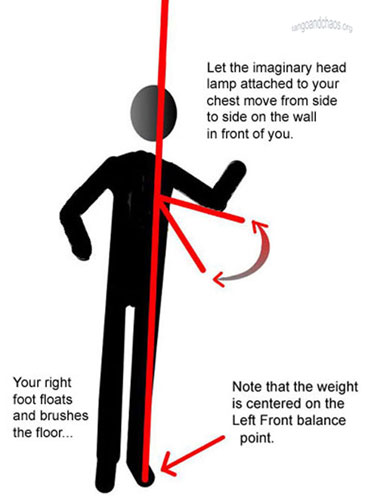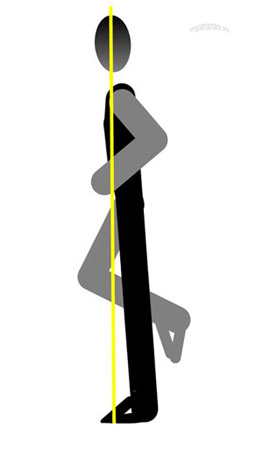Float and Twist
When you're comfortable with the exercises on the previous page, it's time to let your un-weighted foot leave the floor and hover. Move to one of your forward points, get balanced, and then tip just a bit further to the side, so that the all of the weight begins to leave the other foot. Do it smoothly and slowly, until you feel the un-weighted foot just start to leave the floor:

Carefully move straight across to the other side and do the same thing. Your weight smoothly returns to the un-weighted foot, and slowly takes your full weight as you tip the other way. The mid point of your chest moves directly across in a straight line.

The distance your chest moves from side to side isn't very much. It depends on how tall you are, but 7 or 8 inches is about right.
Now let's begin to add a little movement. As your foot floats over the floor, let it move around a little. Maybe make small circles, or let it move slightly side to side. Your leg should hang free and straight, and the ball and front part of your un-weighted foot should just touch the floor. Let it lightly brush over the floor as you make small patterns. Your leg should feel like a pendulum swinging slightly from your hip.
Picture one more thing. Imagine there is a small flashlight or laser pointer attached to the middle of your chest, and it's pointing straight forward. It's like the headlight of a motorcycle, shining on the wall in front of you. It shouldn't move when you're over a balance point. Imagine keeping it completely still as your un-weighted leg swings. You can even try it in a dark room holding a small flashlight against the middle of your chest if you want to.
Again, remember, this isn't a physical workout. If you do things to the point of fatigue, you'll begin to get sloppy. So don't work against yourself—make sure to be relaxed mentally and physically before starting. It's not a workshop where you try to cram in information over a three-day weekend. Take your time and absorb the feeling of each step.
Next, let's move the spot of light a little bit. Start again at Zero, and move forward to your Left Front balance point. The small headlight is still shining from your chest onto the wall in front. We want to move it just a little from side to side:

Twist slightly along the axis that runs from the top of your head
through the center of balance located near the front of your left foot.
Here's what should happen: The left foot is planted, but your head and shoulders rotate slightly. The result is a bit of twisting along the line that runs from the top of your head to your Left Front balance point. Imagine the line as a steady axis of rotation. Your foot is planted and fixed, while your head and shoulders rotate smoothly, so there is a little twisting along the imaginary line, but don't twist very far. The result is that the little beam of light projecting from your chest moves from side to side.
This is not the quick jerky movement they sometimes they teach in classes to lead a boleo. Imagine the spot of light from your chest lamp moving smoothly from side to side with a harmonic motion, like a pendulum attached to the axis of your balance. Put on some music, and imagine this movement is connected to it in some way. Your heels should remain close together, just as they were when you were standing with the weight on both feet, but now, the front of your floating foot describes a tiny arc as it brushes the floor. And the ball of your foot is a tiny pendulum, moving smoothly and harmonically along the arc, from one end to the other.
Practice a few times on both sides: Left foot weighted, right brushing; then right foot weighted, with the left floating and brushing. The two exercises on this page may seem trivial, but they aren't. The first one is the beginning of taking a step, and the one above is the first stage in learning to communicate the melody and sentiment of the music to your partner.
Finally, move again to your front balance points, move all the weight onto one foot, and this time pick up the other foot. Bend your knee a little, and raise your foot so that your free foot moves about halfway up your calf. Use just enough muscle to raise your knee. Your foot should be very relaxed, with the toes hanging down, about 8 inches off the floor. Practice both sides:

Get used to staying balanced for a few seconds on your front balance points with your foot
raised about 8 inches above the floor. Let your foot and ankle relax and hang.
Comin' up... we be learnin' to walk!